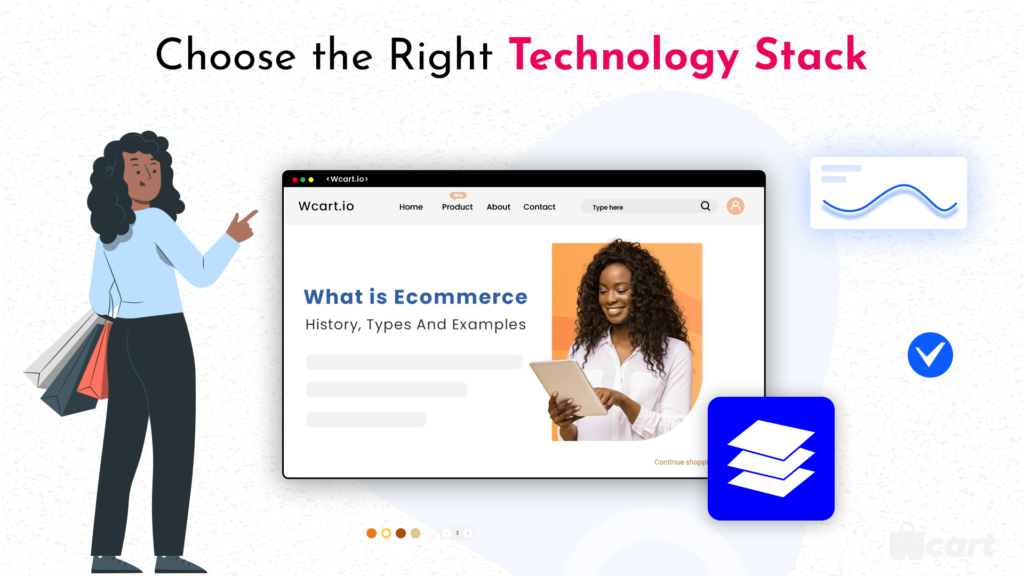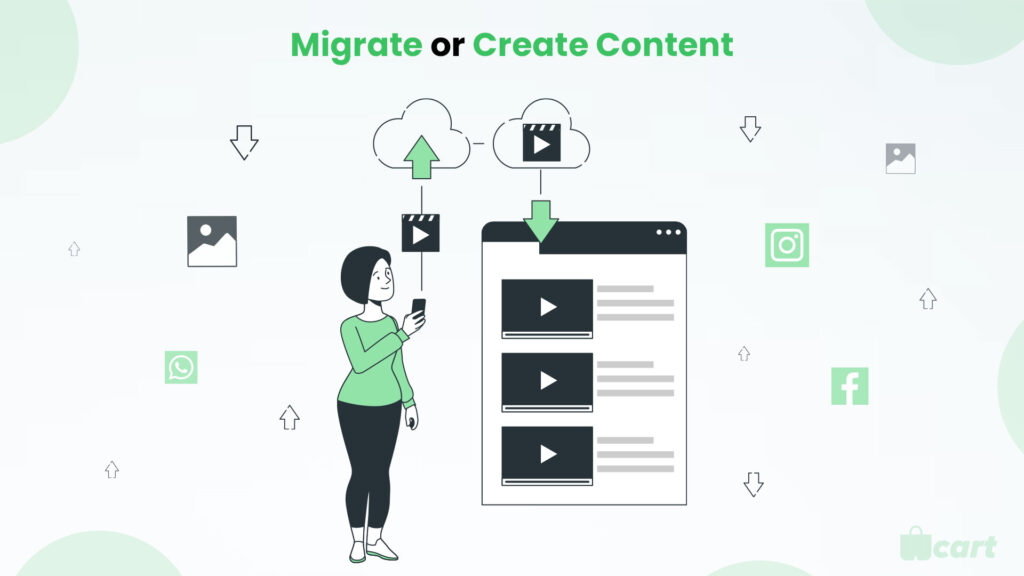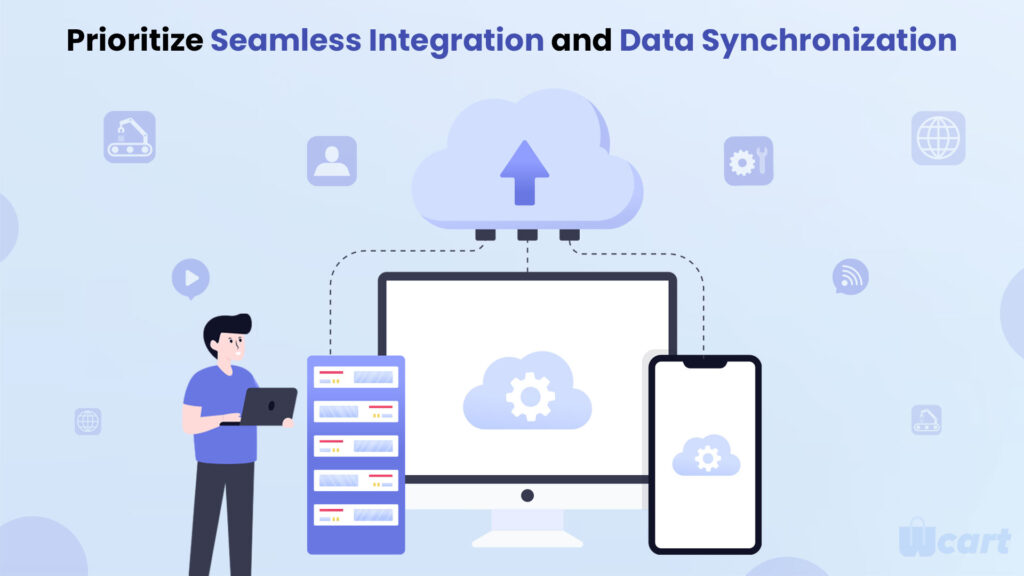Headless ecommerce systems are on the upward push, with recent records displaying that by 2023, 57% of organizations globally are expected to undertake this revolutionary technique. Looking in advance, it is predicted that by way of 2025, 60% of predominant stores in North America will include headless platforms. In this guide, we can explore the concept of headless e-commerce and delve into the blessings it brings to businesses of all sizes. By adopting a Headless ecommerce Solution, companies can advantage a strategic gain and function themselves at the leading edge of their enterprise. So, let’s dive in and find out how headless ecommerce can empower companies to thrive in virtual technology.
Read More: To Know about What is Ecommerce
What Is Headless Ecommerce Solutions?

Headless ecommerce is a cutting-edge approach to building online stores that offer numerous benefits for businesses. Unlike traditional ecommerce platforms where the front and backend are tightly coupled, headless architecture separates these two components, allowing greater flexibility and customization.
In a headless ecommerce solution, the frontend, which is responsible for the user interface and presentation layer, is decoupled from the backend, which handles the business logic and data management. This decoupling is achieved through APIs (Application Programming Interfaces) that enable seamless communication between the frontend and backend.
Headless ecommerce empowers businesses with design freedom, scalability, and seamless omnichannel experiences. By adopting a headless architecture, businesses can create highly customized and engaging user experiences, easily scale their online stores, and deliver a cohesive shopping journey across multiple channels.
Read More: To Know about What is Headless Ecommerce
Benefits of Headless ecommerce Solution

- Enhanced User Experience: With a headless ecommerce solution, you have the freedom to design a unique and captivating frontend experience for your customers. Therefore you can create custom interfaces, personalize content, and deliver targeted messages, leading to improved user engagement and higher conversion rates.
- Scalability and Performance Optimization: Headless architecture allows for server-side rendering and caching, resulting in faster page load times and improved site performance.
- Seamless Omnichannel Experiences: Headless ecommerce empowers businesses to deliver a consistent user experience across multiple channels, i.e. mobile devices, tablets, and even emerging technologies like IoT devices and voice assistants. This capability enhances customer engagement and increases your brand’s reach and accessibility.
- Flexibility for Innovation: Decoupling the frontend and backend empowers businesses to experiment, and implement new technologies, features, and integrations, ensuring uninterrupted ecommerce operations, fostering innovation, and delivering distinctive customer experiences.
- Easy Integration with Third-Party Services: Headless architecture utilizes APIs for data exchange, making it seamless to integrate with various third-party services such as payment gateways, inventory management systems, customer relationship management (CRM) tools, and more. This integration capability enhances the overall functionality of your ecommerce solution.
- Future-Proof and Scalable: While it provides scalability, allowing your platform to grow and adapt to changing business needs and increasing customer demands. As your business expands, you can add new functionalities, and channels, or even internationalize your operations without significant disruptions or limitations.
In summary, a headless ecommerce solution empowers businesses by offering enhanced user experiences, scalability, seamless omnichannel capabilities, flexibility for innovation, easy integrations, and future-proof scalability. By adopting a headless approach, businesses can stay ahead of the game in the ever-evolving ecommerce landscape
Implementing a Headless Ecommerce Solution
Implementing a headless ecommerce solution requires careful planning, collaboration, and the right technology stack. Here are the key steps to consider when implementing a headless ecommerce solution:
Choose the Right Technology Stack:

- Evaluate Frontend Frameworks: Research and select a frontend framework that aligns with your business requirements and development expertise. React, Angular, and Vue.js are among the popular choices for implementing a headless ecommerce solution.
- Select a Backend CMS or ecommerce Platform: Identify a backend system that supports headless architecture and provides the necessary features for your ecommerce needs. Examples include Contentful, Magento, and Shopify Plus.
Develop APIs for Data Exchange:

- Restful APIs and GraphQL: Determine the type of APIs you will use for data exchange between the frontend and backend. Restful APIs and GraphQL are commonly used options. Assess the advantages and considerations of each to make an informed decision.
- Authentication and Security Considerations: Implement secure authentication mechanisms to ensure data integrity and protect sensitive customer information. Consider using tokens, OAuth, or other industry-standard authentication protocols.
Collaborate with Designers and Developers:

- Design a Captivating User Interface: Work closely with designers to create an engaging and visually appealing user interface that aligns with your brand identity and provides a seamless user experience.
- Ensure Smooth Integration and Functionality: Foster collaboration between frontend and backend developers to ensure smooth integration of the design with the ecommerce platform. Test and verify that all functionalities, such as product listing, cart management, and checkout processes, work seamlessly.
Migrate or Create Content:

- Migrate Existing Content: If you are transitioning from a traditional ecommerce platform to a headless architecture, plan and execute the migration of your existing content to the new system. While Ensuring data integrity and making necessary adjustments for the decoupled structure.
- Create New Content: If starting from scratch, develop and organize your content within the backend CMS, ensuring it is structured in a way that aligns with your front-end requirements. Consider content modeling, metadata, and SEO best practices.
Testing and Quality Assurance:

- Conduct Thorough Testing: Perform rigorous testing of the entire headless ecommerce solution, i.e. frontend interactions, API responses, data synchronization, and compatibility across devices and browsers.
- Address Bugs and Issues: Identify and address any bugs or issues that arise during testing, ensuring a smooth and error-free user experience.
Deployment and Launch:

- Deployment Strategy: Plan your deployment strategy, whether it involves deploying to a cloud infrastructure, utilizing a content delivery network (CDN), or other appropriate hosting options.
- Monitor Performance: Continuously monitor the performance of your headless ecommerce solution post-launch. Monitor metrics such as site speed, uptime, and user interactions to identify areas for optimization.
By following these steps, businesses can successfully implement a headless ecommerce solution, empowering them to deliver customized experiences, optimize performance, and integrate seamlessly with external services.
Best Practices for Headless Ecommerce Implementation

Implementing a headless ecommerce solution requires careful planning and execution. To ensure a successful implementation, consider the following best practices:
Conduct Thorough Research and Planning:

- Understand your business requirements: Clearly define your business goals, target audience, and desired features to select the most suitable headless ecommerce solution.
- Research technology options: Explore different frontend frameworks, backend CMS or ecommerce platforms, and API technologies to make informed decisions based on your project requirements and technical expertise.
- Plan the migration or development process: Create a detailed roadmap outlining the steps, timeline, and resources needed for a smooth implementation.
Prioritize Seamless Integration and Data Synchronization:

- Define data models and structures: Plan and design your data models to ensure seamless integration between the frontend and backend components.
- Establish synchronization processes: Implement reliable data synchronization mechanisms to keep data consistent and up to date across different systems and channels.
- Enable real-time updates: Whenever possible, leverage real-time updates through event-driven architectures or web sockets to provide the most accurate and current information to users.
Implement Robust Testing and Quality Assurance Processes:

- Perform comprehensive testing: Conduct thorough testing of the frontend, backend, and API integrations to ensure functionality, compatibility, and performance. Test across various devices, browsers, and user scenarios.
- Test scalability and performance: Simulate high-traffic scenarios to evaluate the scalability and performance of your headless ecommerce solution. Identify and address any bottlenecks or performance issues.
- Implement automated testing: Utilize automated testing tools and frameworks to streamline the testing process, ensure consistency, and facilitate faster regression testing.
Continuously Monitor and Optimize Performance:

- Monitor system performance: Utilize monitoring tools to track system performance, i.e. server response times, API performance, and user experience metrics. Identify and address performance bottlenecks promptly.
- Optimize frontend delivery: Leverage techniques such as code splitting, lazy loading, and caching to optimize frontend delivery and enhance page load times.
- Regularly review and optimize: Continuously review and optimize your headless ecommerce solution to improve performance, scalability, and user experience. Keep up with technology updates and industry best practices.
By following these best practices, businesses can ensure a successful implementation of their headless ecommerce solution. These practices help such as streamline the integration process, ensure data consistency, deliver a high-performing system, and provide a seamless user experience across channels.
Case Studies: Success Stories of Headless ecommerce
Examining real-life e.g. of businesses that have successfully implemented headless ecommerce can provide valuable insights into its benefits and potential impact. Here are two case studies showcasing success stories in the realm of headless ecommerce:
Case Studies 1: Transforming the Customer Journey

- Challenge: A fashion retailer, faced limitations in providing a personalized and engaging user experience through their traditional ecommerce platform. Therefore they wanted to create a unique shopping journey to differentiate themselves in the competitive market.
- Solution: By adopting a headless ecommerce approach with Wcart, a fashion retailer redesigned its frontend using a modern JavaScript framework. They implemented personalized product recommendations, dynamic content, and a visually stunning interface to captivate their customers.
- Results: With the help of the Wcart ecommerce platform, a fashion retailer to deliver an immersive and personalized shopping experience. They witnessed a significant increase in customer engagement, higher conversion rates, and improved customer satisfaction. The unique user experience helped them stand out and build brand loyalty, leading to substantial business growth.
Case Studies 2: Streamlining Operations and Scalability
- Challenge: A growing online marketplace, faced limitations with its traditional ecommerce platform. As their business expanded, they struggled with scalability, performance issues during peak traffic, and difficulties integrating with third-party services.
- Solution: The company adopted a Wcart headless ecommerce platform to overcome these challenges. Hence they decoupled their frontend and backend, allowing for seamless integrations with external services and better scalability. They leveraged a headless CMS for content management and a custom frontend for enhanced user experience.
- Results: With the help of the Wcart platform, that company experienced a significant improvement in performance and scalability. They seamlessly integrated with payment gateways, logistics providers, and marketing automation tools, streamlining their operations. The headless approach facilitated rapid business growth, expanded market reach, and provided a robust foundation for future expansion plans.
Therefore these case studies demonstrate the transformative impact of headless ecommerce. Hence by leveraging a decoupled architecture, businesses can overcome the limitations of traditional ecommerce platforms, deliver unique and personalized user experiences, improve scalability and performance, and streamline operations through seamless integrations. These success stories highlight how headless ecommerce can be a game-changer in today’s competitive digital landscape.
Conclusion
The headless ecommerce solution provides businesses with a customizable and flexible online presence, separating the frontend and backend of the platform to enhance user experiences, improve performance, integrate external services, gain a competitive edge, increased customer engagement, and significant business growth.
Whether it’s transforming the customer journey, streamlining operations, or expanding market reach, headless ecommerce has proven to be a game-changer for businesses seeking to thrive in the dynamic digital landscape. So, Embracing the advantages of headless architecture can empower businesses to elevate their online presence and deliver exceptional user experiences that drive success in the ever-evolving world of ecommerce.
Frequently Asked Questions(FAQs)
What is a headless ecommerce solution?
A headless ecommerce solution is a platform where the front-end presentation layer (the “head”) and the back-end ecommerce functionality are decoupled, allowing for greater flexibility and customization. The front-end can be built using any technology, such as a website, mobile app, or voice assistant, while the back-end manages the ecommerce functionality, including inventory management, order processing, and payment integration.
What are the benefits of using a headless ecommerce solution?
Using a headless ecommerce solution offers several benefits such as it enables faster development and deployment of front-end experiences, as developers can work independently on the user interface without affecting the back-end.
How does a headless ecommerce solution improve performance and scalability?
Headless ecommerce solutions improve performance and scalability by separating the front-end from the back-end. While separation of the frontend and backend in headless ecommerce enables effective delivery of content through content delivery networks (CDNs) and more efficient caching, resulting in faster page load times.
What challenges should be considered when adopting a headless ecommerce solution?
While headless ecommerce solutions offer many advantages, there are some challenges to consider. One of the main challenges is the increased complexity of development and maintenance. As the front-end and back-end are decoupled, it requires skilled developers and additional effort to ensure smooth communication between the two. Another challenge is the potential learning curve for teams unfamiliar with headless architecture. Training and upskilling may be required to fully leverage the benefits of a headless solution.
Is a headless ecommerce solution suitable for every business?
While headless ecommerce solutions offer flexibility and customization options, they may not be suitable for every business. Hence Smaller businesses with limited technical resources or simpler ecommerce requirements may find traditional ecommerce platforms more suitable.




Leave a Reply